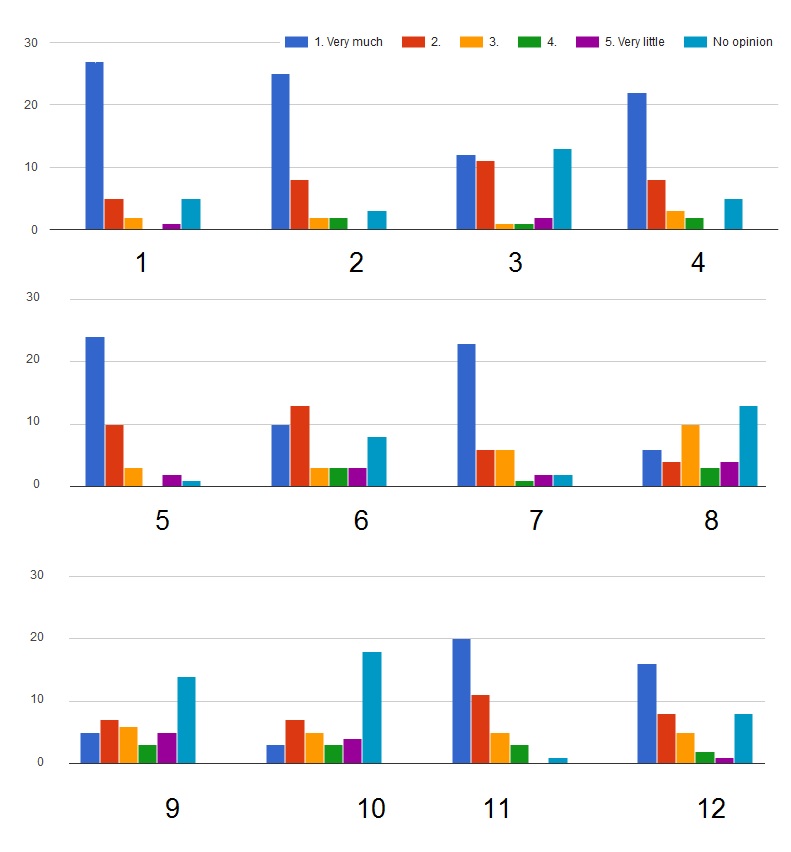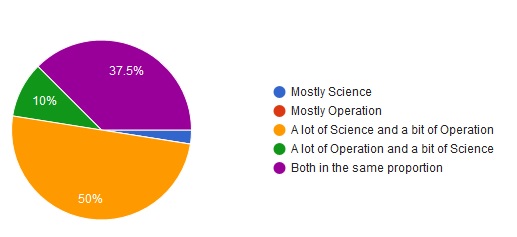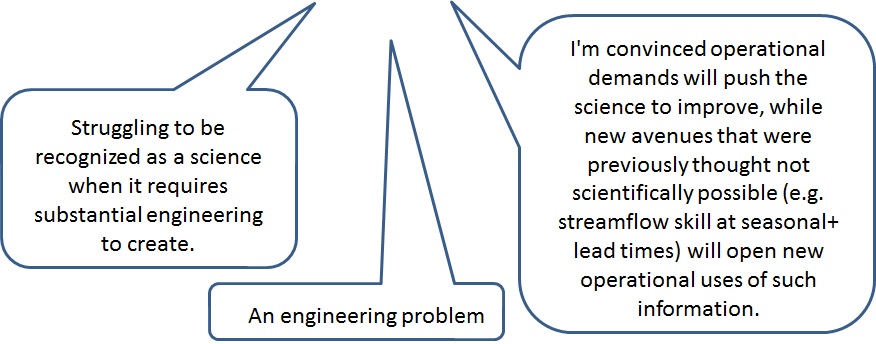Contributed by Maria-Helena Ramos
At the beginning of the year, we launched a short online survey to gather some views and opinions about Hepex and start a discussion on the future of Hepex: how should the community continue its efforts? What should Hepex be in 10 years’ time?
During the 7th International Hepex Workshop in Melbourne we had an interactive poster that complemented this survey and collected some more views and opinions from the participants of the workshop.
Below you will find some interesting results from this survey, summarized from the 40 responses collected and the workshop poster.
Who we are
The online survey received answers from people working all over the world, as can be seen below:
 The answers showed that respondents are:
The answers showed that respondents are:
- more involved in science, operations, ensemble techniques, hydrological modelling and verification;
- less involved in policy making, flood inundation mapping, evaluation of economic value and user-driven evaluation.
See the answers below for:
“How much are you involved in…”
- Forecasting science
- Operational forecasting
- Forecast-based decision making
- Policy making
- Ensemble techniques in meteorology
- Ensemble techniques in hydrology
- Hydrological modelling for forecasting systems
- Flood inundation mapping
- Data assimilation
- Statistical pre/post-processing, bias correction
- Verification of forecast quality
- Evaluation of the economic value of forecasts
- User-driven evaluation of forecast added value
 HEPEX activities:
HEPEX activities: 
A large majority (72.5%) visit the Hepex Blog Portal at least once a month (50%, at least twice a month). Additionally, 90% of the survey respondents say they are satisfied or very satisfied with Hepex.
- The Hepex activities they like most are workshops, sessions or meetings at major conferences, special journal issues, the Blog portal, mailing list and interview posts.
- There was no majority “disliking” a particular activity, but some people said they like “very little” Twitter, LinkedIn and Hepex Daily.
- “No opinion” was more often voted for Hepex Daily, Twitter, LinkedIn and Experiments and testbeds.
“How much do you like the following HEPEX activities?”
- HEPEX Workshops
- HEPEX sessions or meetings at major conferences (EGU, AGU, IAHS)
- HEPEX experiments or testbeds
- Special HEPEX journal issue
- The Blog Portal (www.hepex.org)
- Webinars
- Notifications through the HEPEX Google mailing list
- Communication through HEPEX LinkedIn
- Communication through HEPEX Twitter
- The HEPEX Daily!
- Interview blog posts
- April fools! blog posts
 Some respondents noted that, given limited and volunteer resources, Hepex is already doing plenty of activities. However, some suggested other possible additional activities that we could have in Hepex. The main suggestions are compiled below:
Some respondents noted that, given limited and volunteer resources, Hepex is already doing plenty of activities. However, some suggested other possible additional activities that we could have in Hepex. The main suggestions are compiled below:
Young Hepex-ers, training and outreach:
- A “young HEPEX” subgroup (PhD students and 2-3 years Postdoc) to initiate educational courses and lead tasks, and to guarantee dialogue among new contributors/friends.
- Training sessions, summer school, winter course, MOOC, Education oriented sections (towards young hydrological scientists and more).
- Advanced short courses in best community practice/state of the art hydrological forecasting for next generation of scientists (MSc, PhD, early career scientists).
- More outreach to the public and decision makers to understand the need for probabilistic forecasting over deterministic forecasting.
|
Post-event analyses, testbeds, experiments:
- More post-event analyses, operational points of view, and showcases in different areas.
- More rigorous comparisons and frameworks, international testbeds, and more momentum in experiments/testbeds.
|
Funding & projects, regional activities, science advising:
- Reflecting on how we might collectively begin applying for international research grant programs.
- Funding for HEPEX testbeds.
- Intermittent activity to write an occasional letter to funding programs or agencies advocating for investment in key science areas.
- More regional activities in Asian Pacific.
- HEPEX is in a very good position to influence other scientific communities. How about using this to propose novel common methods for doing and showcasing science? E.g. Should the concept of scientific papers be redesigned to be more concise, where information can be summarised in one diagram? Should we reconsider our approach for experiments design? Should an experiment be designed primarily to solve, explore a user or operational need?
|
Publications, website & tools:
- More common experiments and papers.
- We could identify a handful of barriers in ensemble prediction and application to work on jointly and aim to demonstrate how these are being tackled and what progress has been made in a few short joint papers.
- Collaborative effort to write scientific articles/opinion paper.
- Reviews of published work.
- A web page with relevant publications classified by themes, test bed, applications, etc to facilitate research by the members/contributors. Each publication should have 3 highlights (120 characters each) so that this is more than a repository.
- The web page would also allow reports because many operators will have reports that are precious information, publicly available, just not peer reviewed. That might facilitate in the future some review papers/summary as well.
- A dynamic roadmap that explains the techniques used for each attribute/context and the different steps of the forecasting framework.
- A shared code repository.
|
“Today, Hydrological Ensemble Prediction is…”


“For me, HEPEX is….”
- a way of keeping in touch.
- a community of researchers working on similar / related research topics to myself and my interests.
- a platform to know what is currently ongoing in hydrological science.
- a very useful network to discuss broad scientific and technical questions related to hydrometeorological ensemble forecasts.
- greatly needed to promote ensemble hydrological forecasting.
- a community of scientists with a common interest.
- a great community.
- very important! Keep me update!
- the place to be.
- my scientific family (a bit cheesy but true).
- a friendly and open group of scientists who believe more progress can be made as a collective rather than only individuals.
- mainly a science community.
- an international scientific/user community, in which I can disseminate results from my investigations efficiently, whilst I can get constructive criticism. These are the benefits of being a member of a family.
- a place to be inspired and challenged.
- a very inclusive community of researchers and practitioners furthering the development and use of ensemble prediction methods for streamflow.
- a family.
- an informal community of people interested in hydrometeorological forecasting, trying to stay connected with the latest science and find collaborators.
- a coalition of the willing.
- a community of common ideas and purpose.
- non funded excellence in science done by peers that are also friends.
- a nice resource to keep updated with developments in ensemble forecasting.
- a welcoming, competent and active community!
- an initiative to coordinate world-wide work and advance flood prediction.
- motivation and support.
- a great community of ensemble forecast researchers, users and communicators.
- a community where people exchange ideas and collaborate.
- a collaborative scientific community dedicated to improving ensemble flow forecast and developing its operational implementation.
- the reference community in probabilistic hydrologic forecasting.
- interesting as an outsider.
- the best scientific group I’ve ever met.
- a way to stay connected with the ensemble forecasting community.
- an outstanding example of international scientific community.
- HEPEX is a window that I can view the world of ESP research.
“The future of HEPEX is….”
We could identify four main groups of responses:
| IN GENERAL |
- assured
- fantastic
- very promising for the betterment of mankind
- bright because many opportunities exist
|
SCIENCE AND OPERATIONS
|
- going more operational, and more sub-seasonal.
- as for TIGGE and S2S, have WMO supporting it to provide a range of operational products freely available to everyone.
- a bridge between research and operations, with focus on automation of multi-model ensemble hydrological forecasting, efficient dissemination of information and optimal decision making.
|
COMMUNITY AND MEMBERSHIP
|
- continuing to build its community
- a growing community and enabler of exciting research
- linked to people and surely facing ups and downs
- involvement of more members
- more involvement from the members in the daily work
- more active
- widespread
- the early career scientists!
- to become more interdisciplinary, especially by connecting more with humanities and social sciences.
- resides in continuing in filling the gaps between the diverse communities interested in the many aspects of flood forecasting.
- to promote hydrological ensemble prediction and facilitate exchanges and collaboration.
- remaining HEPEX and keeping the promotion of collaboration both in experiments, ideas, and in training students.
- bridging the gap between research community and operational/end-user community.
|
| POSSIBLE PATHWAYS |
- to be clarified. Either it becomes a group in which everybody wants to have its name but few contribute, or it comes back to something more structured with identified key questions / test cases / methods…
- unknown.
- unclear. It can continue as it is with greater and more balanced investment of time by members to contribute interesting blogs and self-organize to create gatherings/meetings. It can try to become more formal, perhaps with a certain funding to support dedicated effort toward website management. Or it can fade away, having performed well for 10 years in drawing attention to the value of hydrologic ensemble forecasting
|
“The future of hydrological forecasting is….”
Three main aspects are highlighted in the responses:
| TECHNIQUES |
- ensemble forecasting
- ensemble-based across all space-time scales
- seamless ensemble forecasts covering short to extended range lead times
- offering ensemble forecasts that seamlessly integrate over space (from sub-catchments to continents) and through lead-times (hours to years)
- an Earth System that provides seamless predictions and integrates decision-making processes
- made of probabilities and data assimilation
- the correction of forecasting bias and errors
- probabilistic, impact-based
- based on multi-model / multi-system forecasting, and impact-based forecasting
- in using alternative data sources and using sophisticated pre- and post-processors to improving ensemble forecasting
- in combining information from many different (sometimes competitive) sources
|
| SCIENCE |
- lies with more basic scientific understanding
- understanding more sophisticated interaction between the atmosphere, rivers and humans
- to integrate meteorology/climatology, hydrology, forecasting services and water management
- on the one hand proposing scientific innovations that make sense for operations (not unrealistic/disconnected from operational constraints) and gradually including hydrological forecasting in a much broader perspective, or system approach, of integrated water resources management
- bright if we a.) integrate hydrology even better within meteorological forecasting systems, and b.) make progress towards better understanding what a ‘useful’ degree of skill means in practice… e.g. is a forecast with a CRPSS of 0.06 useful and to whom in what situation?
- somewhat linked to progresses in meteorological forecasting and remote sensing
- to find its role in the next generation of high-resolution process-resolving NWP models
- to provide consistency and knowledge as new coupling techniques are developed
- There is now less research on improving the representation of hydrological processes but rather representing the uncertainty in their representation.
- New research is toward extending the application of the forecast into estuary models, inundation maps, hydropower, infrastructure safety, etc.
|
| COMMUNICATION AND NEW SYNERGIES |
- more reliable, and user friendly / automation
- communication and interaction with social media / communicate probabilities
- challenging / promising / very important due to climate change in the world
- to find synergistic value from both ensemble systems and high resolution deterministic systems so that the field is not split into two camps, those that pursue resolution and complexity and those that try to quantify uncertainty
- a rosy one, provided there are sufficient links between research advances and operational services and applications to improve water management
- clouded because there is no clear leadership for the direction needed. The science is there, but policy needs to be established.
|
In summary…
This survey is the first step into a discussion that will certainly help us moving forward with updated goals to better tackle the main challenges the community face today, almost fifteen years after the first meeting that launched HEPEX as a novel experiment in the international hydrological sciences community.
A big “thank you” to all those who took their time to answer and participate!
If you have any additional comments, post them in the comment box below.
Survey organizers: Maria-Helena Ramos, Fredrik Wetterhall, Andy Wood, QJ Wang, Florian Pappenberger, Jan Verkade, Hannah Cloke, Ilias Pechlivanidis, and François Anctil.
Like this:
Like Loading...
 The answers showed that respondents are:
The answers showed that respondents are: Some respondents noted that, given limited and volunteer resources, Hepex is already doing plenty of activities. However, some suggested other possible additional activities that we could have in Hepex. The main suggestions are compiled below:
Some respondents noted that, given limited and volunteer resources, Hepex is already doing plenty of activities. However, some suggested other possible additional activities that we could have in Hepex. The main suggestions are compiled below:


0 comments